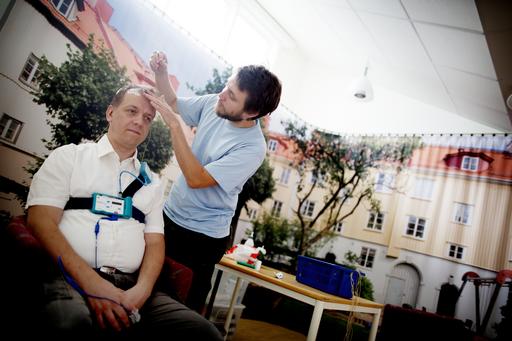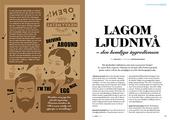
Sound environment and health
Short description
We conduct interdisciplinary research on the importance of the sound environment for human health in a life cycle perspective. Our vision is that people are entitled to a sound environment that contributes to good health and quality of life in all ages. Our research includes epidemiological and experimental studies. A large part of our focus is now on how children are affected by noise during their development. Other important research areas are the impact on hearing and health in female-dominated workplaces and the long-term impact of noise in the living environment. Our unique sound environment laboratory, built in 2006, has well-controlled sound and vibration exposure in a homely environment, which provides good opportunities to investigate the effects of noise and vibration on, for example, sleep.
Research areas
We research sound and noise in four different main areas:
- Environmental noise: Noise from wind turbines, train traffic and road traffic affect people's health and well-being.
- Noise in female-dominated occupations: Effects of work-related noise. The focus is on communication-intensive occupations such as school, preschool and healthcare, where the majority of employees are women.
- Children and noise: How children are affected by noise. Our projects have mainly focused on the sound environment in preschools and schools.
- Low-frequency noise: Since 1985 the research group has investigated how low-frequency noise affects humans. Among other things, the group has been responsible for the scientific basis for the Swedish limit values for low-frequency indoor noise (SOSFS 1996:7 revised 2005:6) and low-frequency noise in the work environment (AFS 2005:16).
Current research projects

History
Research on the effects of noise has been performed within Occupational and Environmental Medicine at the University of Gothenburg (formerly Environmental Medicine) since as early as 1975. In the beginning the research was mainly focused on effects of road traffic noise, such as general noise disturbance and sleep disturbance, which were highlighted in a series of experimental studies in the previous sound laboratory. The early field studies were conducted both in industrial environments and in residential areas, where both the effects of road traffic and air traffic were highlighted.
Later, the research has been expanded to include other types of noise sources such as train traffic, low-frequency noise and wind power, other types of effects, as well as research on health-promoting positive soundscapes.
The Sound Environment Laboratory

A unique sound environment laboratory was built in 2006. It is located at the Occupational and Environmental Medicine, Sahlgrenska Academy at University of Gothenburg. The laboratory enables studies on how different sound environments affect us humans, with well-controlled conditions, for example noise from different types of transportation, ventilation noise, interaction between sound environment and visual environment and between sound and vibrations. The effects we assess mainly relate to general noise disturbance and sleep disturbance, effects on speech communication, learning, recovery, emotional states, and work performance.
The lab has two floors. Upstairs is the control room with the sound system and four exposure rooms with very low background noise: three bedrooms and one larger exposure room where the interior can be adapted for the specific project. On the ground floor is a home-like apartment, which is used mainly by participants in sleep studies who live in the laboratory for up to a week.
The laboratory is specially designed with the goal that background noise level should be below the hearing threshold. Each exposure room is built as a separate module, which isolates the rooms from ground borne noise or vibration from the outside. The ventilation system is specially designed with the air coming from a damped, separate fan assembly located elsewhere in the building. In the rooms, the air diffuses silently. The background noise level from the ventilation is very low, about 13 dBA. The acoustic features of the rooms are specially designed to obtain as evenly distributed a sound field as possible. The walls are slanted to reduce regular sound reflections and several hundred speakers are placed in walls, ceilings and corners to be able to produce a sound field that spreads evenly. The sound is controlled digitally from a separate control room and the system provides good conditions for simulating widely differing sound environments.
You can find more detailed information on the acoustic properties of the laboratory (report in Swedish): Sound laboratories - verification of sound fields (pdf)

Collaboration, sound demonstrations and leasing
The sound environment laboratory is also used for audio demonstrations and the laboratory can be leased. For example, employees at the Swedish Transport Administration have visited the laboratory and got to experience how 55 decibels from road traffic noise sounds like in different environments and how vibrations from trains feel like when lying in a bed. We are also open to collaboration in interesting research projects!
Please contact Kerstin Persson Waye for more information.
Scientific publications
You can find all our scientific publications via each researcher's personal page (links in the box "The participating researchers and their publications").
Key publications
Sandström, L., Persson Waye, K., & Fredriksson, S. (2025). Effect of preschool sound exposure on children’s hearing function: Results from preparatory studies assessing hearing function by distortion product otoacoustic emissions. International Journal of Audiology. https://doi.org/10.1080/14992027.2025.2459228
Vincens N, van Kempen E, Ögren M, Persson Waye K. (2024). Living close to railways: Cross-sectional analysis of ground-borne vibrations and vibration annoyance. Transportation Research Part D: Transport and Environment 136:104458.
Kerstin Persson Waye, Jesper Löve, Peter Lercher, Angel M. Dzhambov, Maria Klatte, Dirk Schreckenberg, Christin Belke, Larisa Leist, Gordana Ristovska, Sonja Jeram, Katja M. Kanninen, Jenny Selander, Arzu Arat, Thomas Lachmann, Charlotte Clark, Dick Botteldooren, Kim White, Jordi Julvez, Maria Foraster, Jaakko Kaprio, Gabriele Bolte, Achilleas Psyllidis, John Gulliver, Hendriek Boshuizen, Alessandro Bozzon, Janina Fels, Maarten Hornikx, Peter van den Hazel, Miriam Weber, Marco Brambilla, Ella Braat-Eggen, Irene Van Kamp, Natalia Vincens. Adopting a child perspective for exposome research on mental health and cognitive development - Conceptualisation and opportunities., Environmental Research, Volume 239, Part 1, 2023, 117279, ISSN 0013-9351, https://doi.org/10.1016/j.envres.2023.117279.
Vincens, N., & Persson Waye, K. (2022). Railway noise and diabetes among residents living close to the railways in Västra Götaland, Sweden: Cross-sectional mediation analysis on obesity indicators. Environmental Research, 212, 113477. doi:https://doi.org/10.1016/j.envres.2022.113477
Persson Waye K, Karlberg J. Sound Quality Characteristics of Importance for Preschool Children’s Perception and Wellbeing After an Acoustic Intervention. Frontiers Built Environ 2021, vol.7, No.91
Smith, M. G., Ögren, M., Thorsson, P., Hussain-Alkhateeb, L., Pedersen, E., Forssén, J., ... & Persson Waye, K. (2020). A laboratory study on the effects of wind turbine noise on sleep: results of the polysomnographic WiTNES study. Sleep, 43(9), zsaa046.
Fredriksson, S., Kim, J. L., Torén, K., Magnusson, L., Kähäri, K., Söderberg, M., & Persson Waye, K. (2019). Working in preschool increases the risk of hearing-related symptoms: a cohort study among Swedish women. International archives of occupational and environmental health, 92(8), 1179-1190.




